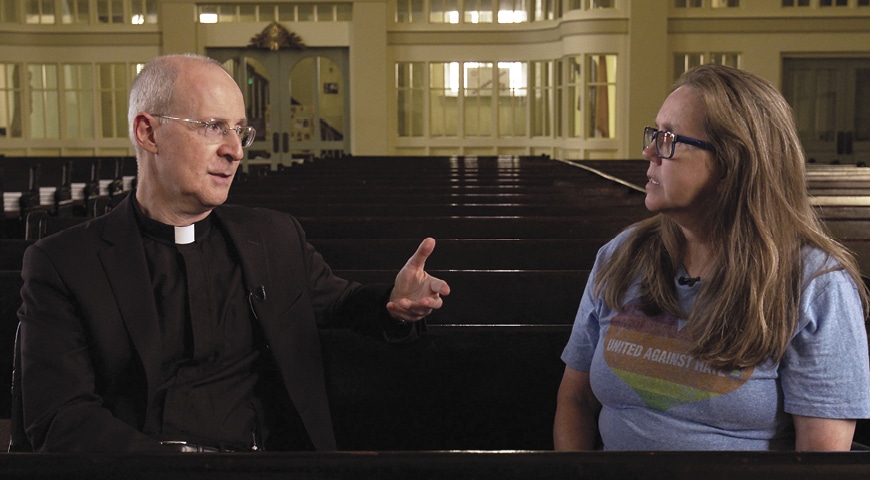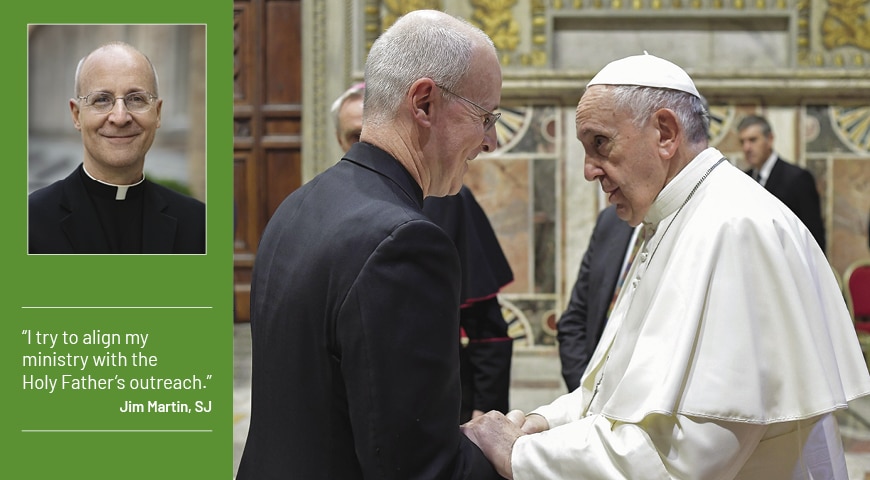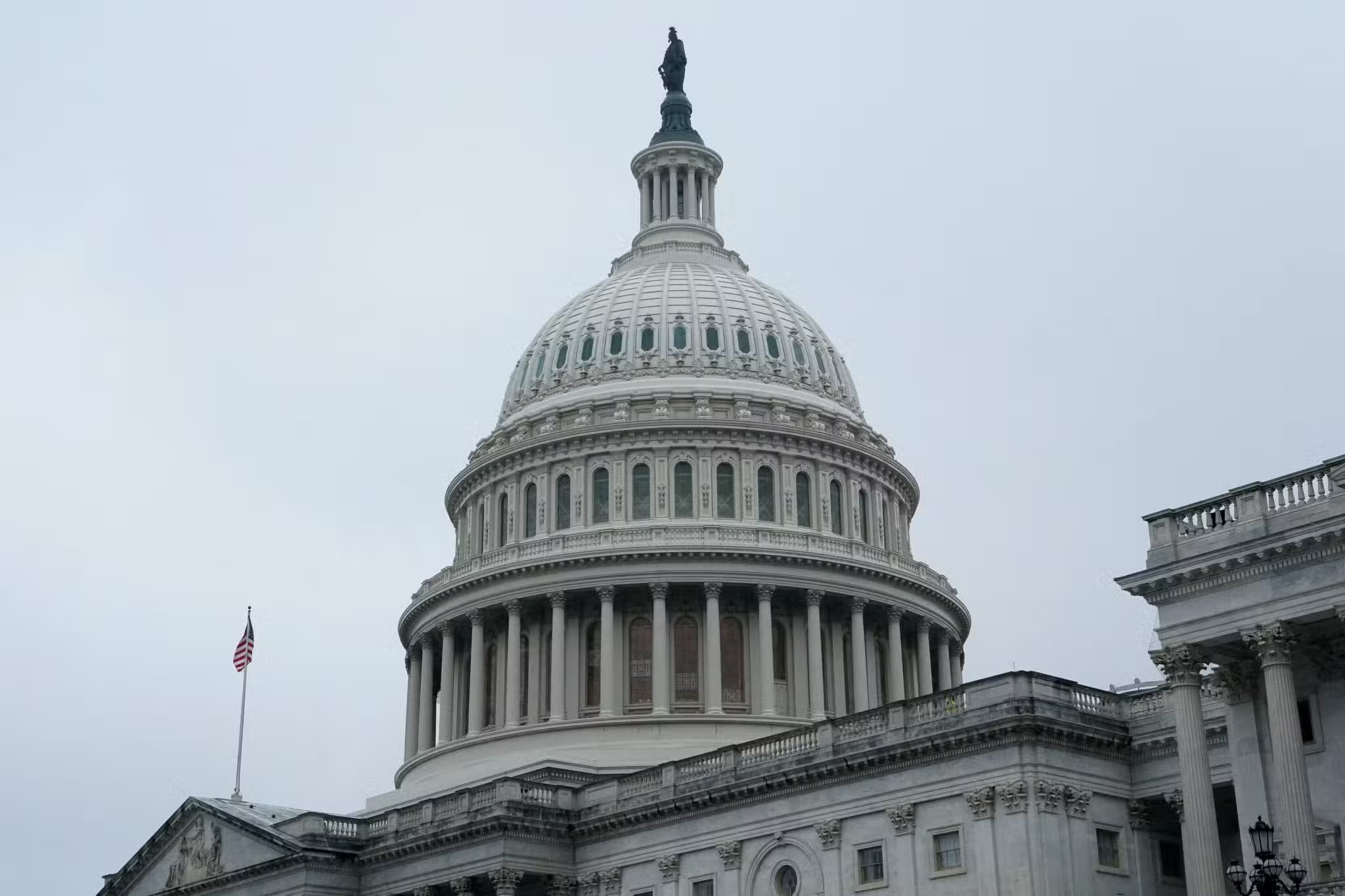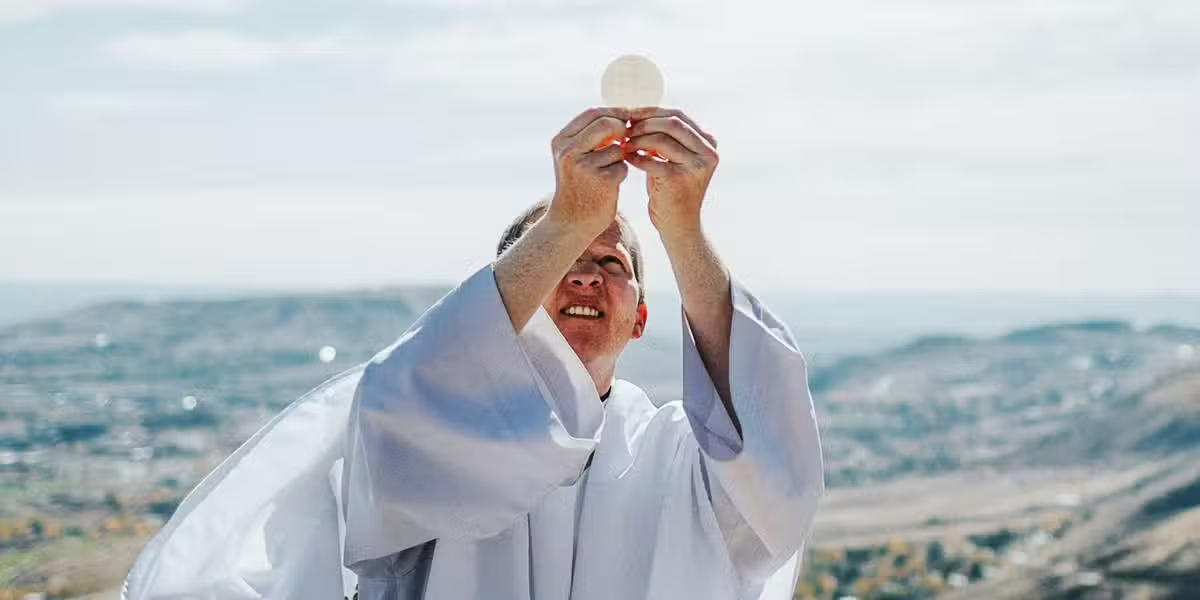Someone you love has come out as LGBTQ. Jim Martin, SJ, offers ways to respond with love, respect, and compassion.
In 2013, I saw a documentary I have never forgotten. Facing Fear tells the story of a former teen skinhead, Tim Zaal, and a gay teen, Matthew Boger, whom Tim thought he had killed on a wild night of gay-bashing with 14 others in West Hollywood in the early 1980s.
Matthew’s mother had kicked him out of the house at the age of 13 when he told her he was gay. He lived on the streets of West Hollywood for four years. Tim grew up in an all-White neighborhood east of Los Angeles. When his brother was shot by a Black man, Tim blamed all people of color and became a White supremacist.
In a twist of providence, Matthew and Tim met years later at the Museum of Tolerance in Los Angeles, where Matthew worked and Tim, now a father and a changed man, volunteered. When they recognized each other, they walked away. But the museum leadership asked them to speak to students and groups about their story. Forgiveness and friendship grew out of getting to know one another.
After seeing the film, I couldn’t understand how a parent could kick out her young teen son because he was gay. Matthew’s mother said it was because no one living in sin could live in her home.
Violence against LGBTQ persons is increasing in the United States. The Human Rights Campaign reports that in 2020 the FBI found that hate crimes “based on sexual orientation represent 16.7 percent of hate crimes, the third largest category after race and religion.” But because cities are not mandated to report hate crimes, these numbers are probably much higher.
“Suicide rates among young people have been on the rise in recent years, according to the Centers for Disease Control and Prevention,” reported Dan Avery in an article for NBC News in April 2021, “but gay and bisexual youths are almost five times as likely to have attempted suicide as their straight peers.” In addition, AmericanProgress.org notes that there are between 1.6 million and 2.8 million homeless youth in the United States, and a disproportionate number are LGBTQ youth.
I interviewed Jesuit Father James (Jim) Martin, an advocate for the LGBTQ community, about this reality. Father Martin is the author of the 2018 best seller Building a Bridge: How the Catholic Church and the LGBT Community Can Enter into a Relationship of Respect, Compassion, and Sensitivity and is the subject of the 2021 documentary Building a Bridge.
What Should Parents Do?
Father Jim, you are a compassionate advocate for members of the LGBTQ community. What are parents to do when their children “come out” to them? What if the children are teens or young adults?
The most important thing is to love your child. Every parent knows this, but often they feel unequipped to respond when their child comes out. I often say to parents, “You know more than you think you do.” In this case, you know how to love.
Listening is a big part. Listen to your child’s experiences. Don’t be afraid to ask questions, but always communicate your love and acceptance. Coming out can be a difficult thing for a child.
They’re talking about sexuality, something that’s difficult for any child to discuss with parents. But one of the most crucial things for the mental health of LGBTQ youth is parental acceptance. And one of the main reasons for teen homelessness is LGBTQ kids being kicked out of their houses—by the way, usually for “religious reasons.”
There are, of course, differences in how one deals with a teen versus an adult and times when psychotherapy helps—not because being LGBTQ means being mentally ill, but to help the person through the process. But, in the end, it’s about love.
Remember that God has given you this child, and so God will give you the grace to love them, even if they turned out different than you expected. Are you willing to allow yourself to be surprised and even challenged by the mystery of God’s ways?

What are the three most important things parents can do for their children who are LGBTQ?
Love. Listen. Accompany. Love first. One of the best ways to communicate this is to respond by saying things like, “Thank you for telling me.” “You know I will always love you.” “I’m so grateful you’ve shared this part of yourself with me.” Listening means hearing their sorrow and pain, as well as their joy and hope. Parents are often surprised that for many young people today, coming out is seen as something to celebrate—because they are coming to a deeper understanding of who they are. Finally, accompany. Your child may be going through some changes, perhaps in how they dress, perhaps regarding their friends, perhaps their taste in music. Think of it as a pilgrimage you’re going on with them.
Building a Bridge: The Book and the Movie
What was the best part about making the documentary Building a Bridge?
Seeing how the film brought together so many different voices. The filmmakers did an amazing job of including LGBTQ Catholics, parents of LGBTQ kids, theologians, parish ministries, and so on. It’s a reminder that this issue does not affect just LGBTQ people themselves, but the whole Church. I was also glad that they captured some of the pain and struggles of LGBTQ youth. Often people say, “What’s the big deal?” Well, in the film you see what the big deal is.
In the film, you talk about changes you made between the first and second editions of your book Building a Bridge. Can you tell us about them?
The first edition of the book was simple and short. The first part was based on a talk I gave, and the second was a series of Gospel meditations to invite readers to see how Jesus reached out to those on the margins. But even in the few months after the book came out (no pun intended), I saw that it needed to be revised and expanded a great deal.
To begin with, the LGBTQ Catholic community challenged me on the idea of a “two-way bridge.” Both “sides”—LGBTQ Catholics and the institutional Church—need to reach out to one another. But I had to make it clearer that the onus is on the institutional Church to take the initiative, since it is in a position of ecclesial power. As one LGBTQ Catholic said: “We’d love to talk with bishops. But some of them won’t meet with us.”
Also, there were many more stories and insights, as well as facts and figures, which I wanted to include, especially when I saw how the book was being used by parishes and schools. I didn’t set out to write a resource, but that’s what it has become, since there are so few books written on the topic from a Catholic perspective.
Threats to the LGBTQ Community
One of the most concerning things is the lack of a pastoral response as Church to anyone who identifies as LGBTQ who attempts suicide and/or self-harm. How do parents, teachers, pastors, and others respond to this reality?
You highlight one of the most important aspects of this ministry. Suicide is a life issue. So we need to defend the lives of LGBTQ people as much as the lives of the unborn child in the womb, the refugee at the border, or the elderly person dying of COVID-19. Violence, beatings, and harassment are also commonplace. Sadly, the Church has spoken up hardly at all on this issue.
It’s even worse overseas. Did you know that in 70 countries being gay is a criminal offense, and in 10 countries you can be executed for being gay? This is an area in which the Church can take a stand without changing any teaching. In fact, combating LGBTQ suicide and opposing violence against them supports Church teaching.
Why do people respond with violence to members of the LGBTQ community? Some cite fear of the unknown or fear that God will disapprove of them for being kind. What do you think?
I agree. It’s primarily a fear of the “other.” And religion, sadly, sometimes contributes to this. If you consistently condemn people, speak of them exclusively in the language of sin (when we’re all sinners), and single them out in homilies and bishops’ statements, then it becomes easier to think they are a threat. We see this over and over in history: the targeting, demonization and, eventually, dehumanization of a marginalized group. Recently, one bishop said that transgender people don’t even exist. I can’t imagine language that is more dehumanizing than that.
But it’s also about a person’s own interior life. In the past five years, I’ve spoken to many psychiatrists and psychologists about the rage that is often directed at LGBTQ people (and this ministry). To a person they say, “It’s about something going on inside of them.”
The most rageful people are usually those who are the most conflicted about their own sexuality, and it’s easier to direct that anger outward. We should never underestimate how much of that is in the Church.
The Role of Church and Society
In June 2021, Pope Francis wrote to you: “Thinking about your pastoral work, I see that you are continually seeking to imitate this style of God.” How did this affirmation from the Holy Father make you feel? How is your pastoral work aligned with the agenda of Pope Francis, who welcomes and encourages members of the LGBTQ community to come to Mass and send their children to Catholic schools and religious instruction?
The Holy Father’s support means everything to me. In 2019, Pope Francis invited me to meet with him for 30 minutes in the Apostolic Palace, where we discussed LGBTQ ministry. At the end of that meeting, he asked me to continue my ministry. But I didn’t feel that I could share that with the public. Then last summer I learned that I would be able to share the letter he had sent, which was a great blessing. And remember, as a Jesuit, he is also my boss. By the way, everything I do in this ministry comes after asking for permission from my Jesuit superiors.
I try to align my ministry with the Holy Father’s outreach: showing welcome, reaching out to a group on the margins, and helping them find their place in what is, after all, their Church too.

Why are some well-intentioned members of the Church or any faith community so averse to admitting that a person does not choose to be LGBTQ but is born that way, and that God loves that person regardless of his or her sexual orientation?
Frankly, I have no idea. Nearly every reputable psychiatrist, psychologist, biologist, physician, and social scientist—not to mention LGBTQ people themselves and their parents—will tell you this, but some people refuse to believe it.
Some of this is from fear, which can lead to hatred. The New Testament says, “Perfect love drives out fear.” Well, perfect fear drives out love too.
There is still an alarming amount of homophobia in our Church. I don’t mean sincere misunderstanding or even critiques of LGBTQ ministry; I mean hatred. I suppose that if someone is forced to admit that a person is born this way, it may threaten how they have been dealing with sexuality overall—and perhaps with human anthropology—and that may lead to denial.
Is there a mystery in attempting to reconcile our call to faith, hope, and charity with our brothers and sisters who identify as LGBTQ? What should we do when we don’t understand the words of Scripture and the reality of persons in our families or communities?
The mystery is how so many people can judge them when Jesus says not to judge, and hate them when Jesus says to love. When we look at the Bible, we also need to understand a few things. First, we need to understand the passages about homosexuality in their historical context and remember that Catholics are not fundamentalists. Sometimes I ask people, “Do you think that we should stone people who commit adultery?” And they say, “Of course not.” And I say, “Why not? That’s in the Bible too.” Most people are fine with understanding those lines in a different way today. But when it comes to homosexuality, suddenly we’re all fundamentalists.
But the more basic lesson of the Scripture is how Jesus reached out to those on the margins.
Just look at the stories of him encountering the Roman centurion (who wasn’t Jewish), the Samaritan woman (who was in an irregular sexual relationship), and Zacchaeus (who was a hated tax collector). These are all people on the margins in various ways, as LGBTQ people are in the Church. And what does Jesus do? He listens to them, accompanies them, and loves them. We need to pattern ourselves after Jesus. Otherwise, what’s the point?
What role can the entertainment arts play in educating people about the complexities of LGBTQ issues?
We can’t underestimate the influence that the arts and popular culture have in terms of helping the world see LGBTQ people as human beings. Think of shows like Will & Grace, Ellen, and, more recently, Jeopardy!, where a transgender person became one of the most winning contestants in the show’s history. For those who don’t have contact with many LGBTQ people, these shows helped to show them in their humanity.
On a more serious note, we also have movies about conversion therapy like Boy Erased, which show us the wrong way to deal with LGBTQ people. So, I think the arts community has an important role to play.
How can parents gain a new perspective on LGBTQ lifestyles and the psychological dangers of rejection? What can we do when parents are unwilling to stop their condemnation?
The last thing that LGBTQ kids (and LGBTQ people in general) need is more trauma. I don’t want to paint them as always victims—like anyone, their lives are filled with joy too—but we can’t underestimate how challenging their lives are. While there is growing acceptance for LGBTQ people, they still face immense hurdles, especially in finding welcome in the Church.
In cases where parents refuse to listen to experts or feel that they’re doing something immoral by accepting their children, we must help these kids feel loved by God—and welcome in the Church—any way that we can.









3 thoughts on “Walking with the LGBTQ Community: An Interview with Jim Martin, SJ”
I am gay. I had to drop out of the seminary after 5 years. I was steeped in the belief that I was wrong. I fought my same sex attraction for about 25 years. I accepted being gay which brought some inner peace but did not choose an authentic life. I was married and had two adopted children educated & experienced in mental health care. I did not to submit the children to another abandonment experience. While still active in the Catholic Church, I sang in choirs, taught Catechisis, participated in parish leadership and study groups. I was expelled from a Secular Ministry program when they learned I was gay. It was then that I began seeking an accepting worship community. Today I am active in an Episcopal Worshipping Community. For me, I am worshipping and belong as a member to the same tradition I was brought up in – except I don’t have to fight against who I am. Yes, there has been some improvement in the acceptance of LGBTQ+ people, we are not accepted as normal and accepted as any other human being. I admire Pope Francis but until the church rejects and actively educates people about the error in Ratzinger’s Catechism, that gay people are “intrinsically disordered” there can never be honest acceptance of LGBTQ+ people in the Roman CHurch. I know you try to empathize, Father, but no way can you feel the hurt of rejection and condemnation that we who have been victims experienced. Namaste. ????
I’m a trans woman who’s path in many ways parallels that of the previous comment or, David. I just want to thank you for writing and publishing this, it means a lot. But I would also reiterate what he said about Pope Benedict’s catechism. Without that change, I really don’t see genuine acceptance happening within the Roman Church.
And to anyone reading this who might be struggling right now, I would like to invite and welcome you to the Episcopal Church. After a great deal of study and contemplation, I think it really can be considered validly one of the three ancient branches of Christianity as much as the Catholic and Orthodox are.
May God bless you all!
The loving thing is to bring them back to Christ! Romans 1 is clear